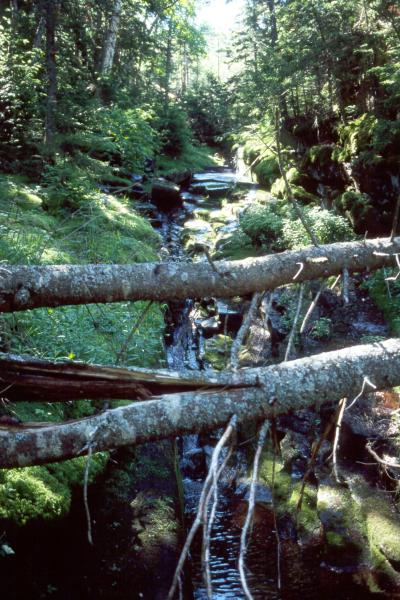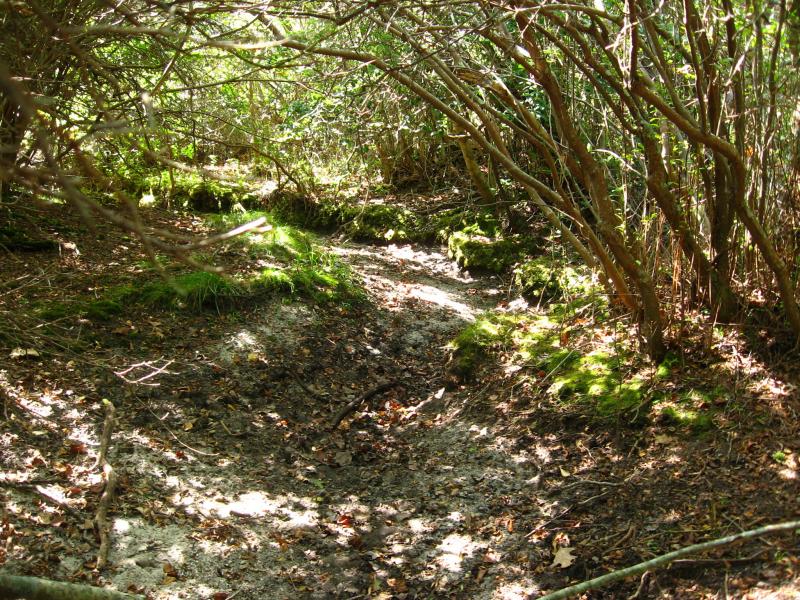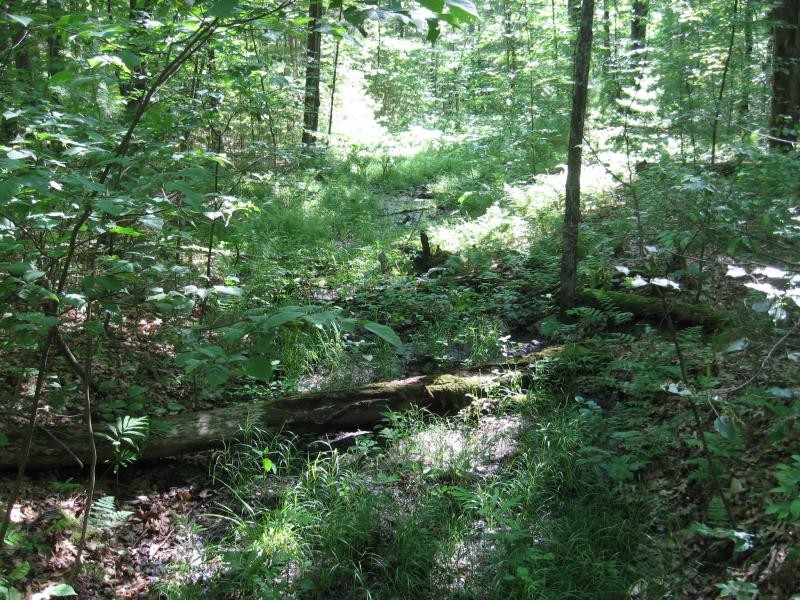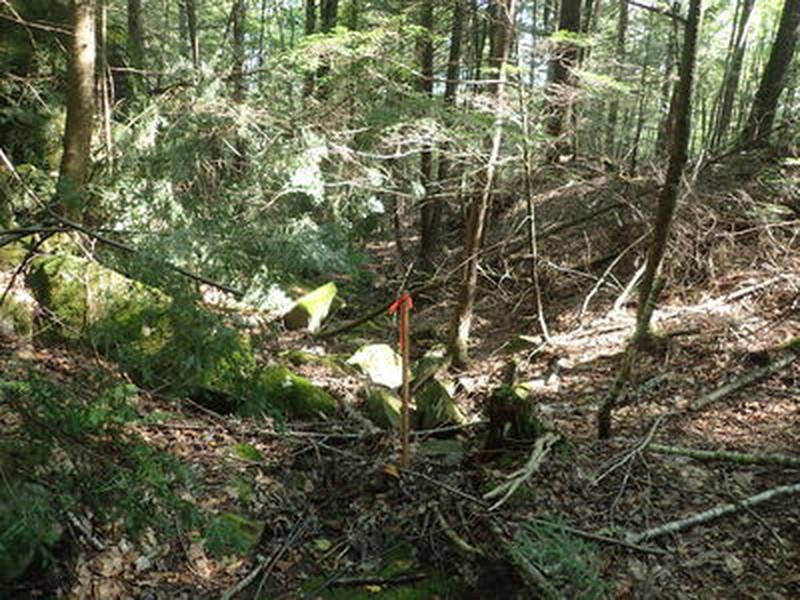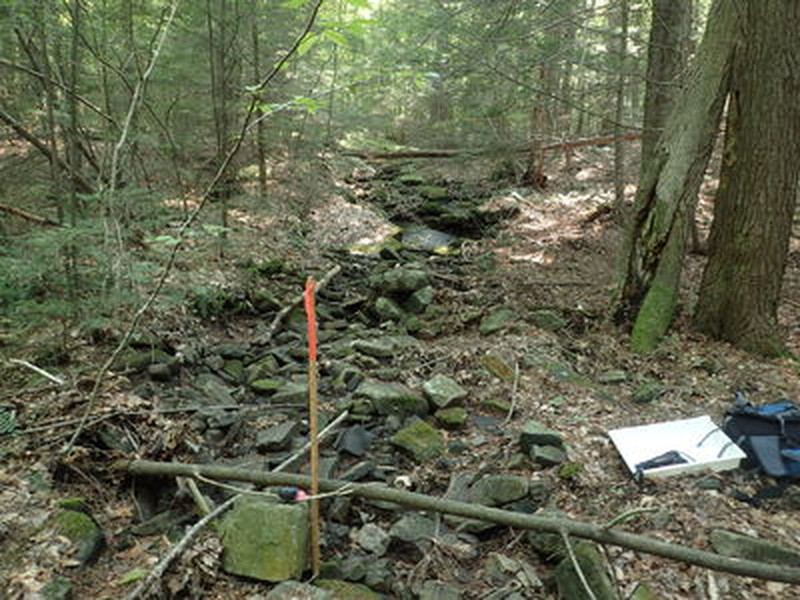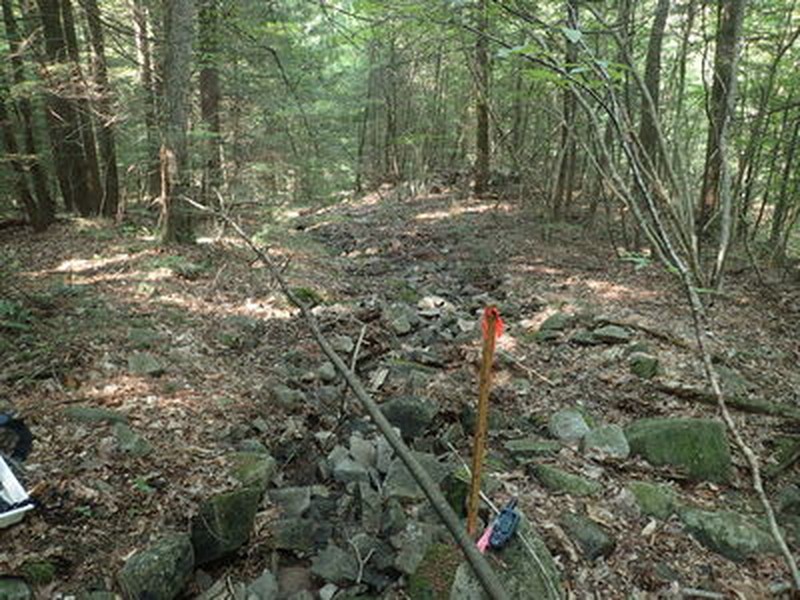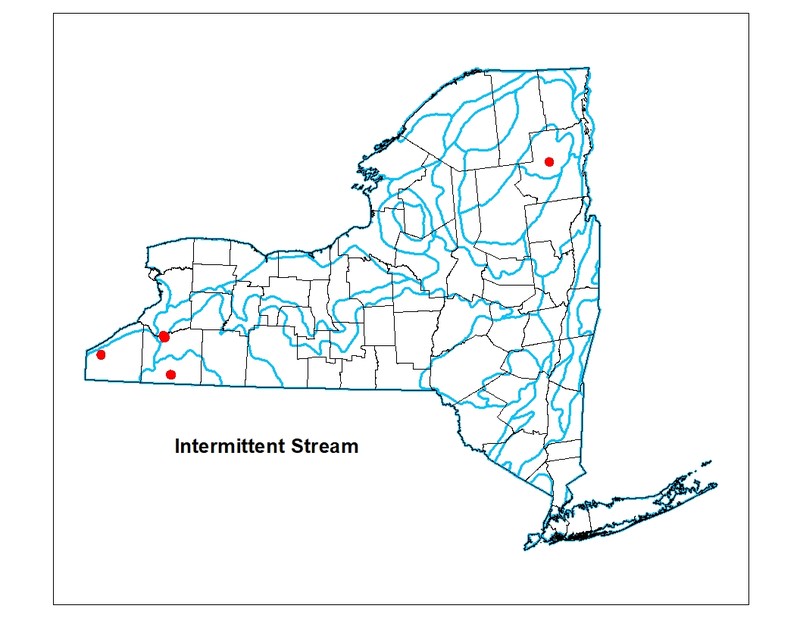Intermittent Stream
- System
- Riverine
- Subsystem
- Natural Streams
- State Protection
- Not Listed
Not listed or protected by New York State.
- Federal Protection
- Not Listed
- State Conservation Status Rank
- S4
Apparently Secure in New York - Uncommon in New York but not rare; usually widespread, but may be rare in some parts of the state; possibly some cause for long-term concern due to declines or other factors.
- Global Conservation Status Rank
- G4
Apparently Secure globally - Uncommon in the world but not rare; usually widespread, but may be rare in some parts of its range; possibly some cause for long-term concern due to declines or other factors.
Summary
Did you know?
Intermittent streams are ephemeral waterways that serve as conduits only during particularly wet and rainy times of year. They are typically the uppermost reaches of stream systems. During spring snow melt and heavy rains, intermittent streams fill with water, draining the surrounding watershed, and transporting nutrients to the lower stream reaches. As with other ephemeral aquatic communities such as vernal pools, flora and fauna that inhabit intermittent streams are specially adapted for a wide range of hydrologic conditions. These communities can transition from being a coursing stream, to having remnant ponded sections, and then to being completely dry during a single growing season.
State Ranking Justification
There are probably tens of thousands occurrences statewide. Intermittent streams are typically small and may be overlooked as streams after the water draws down. A few documented occurrences have good viability and are protected on public land or private conservation land. This community has statewide distribution, and includes several high quality examples. The current trend of this community is probably stable for occurrences on public land, or declining slightly elsewhere due to moderate threats related to logging in adjacent forests, recreational overuse by ATVs, and alteration to the natural hydrology. This community has probably declined moderately from historical numbers likely correlated with logging and development of the surrounding landscape.
Short-term Trends
The number and acreage of intermittent streams in New York have probably remained stable or have slightly declined in recent decades. Their relatively small size and seasonal hydroperiod may have contributed to the decline with many occurrences going undetected.
Long-term Trends
The number and acreage of intermittent streams in New York have declined moderately from historical numbers, likely correlated to the alteration to the natural hydrology and direct destruction.
Conservation and Management
Threats
Intermittent streams are threatened by development and its associated run-off (e.g., roads and bridges, logging in adjacent forests) and recreational overuse (e.g., ATVs, trampling). Alteration to the natural hydrological regime is also a threat to this community (e.g., impoundments). Intermittent streams may be threatened by invasive species. In forested settings intermittent streams are threatened by logging practices and other development that exclude stream protection.
Conservation Strategies and Management Practices
Where practical, establish and maintain a natural stream buffer to reduce storm-water, pollution, and nutrient run-off, while simultaneously capturing sediments before they reach the intermittent stream. Buffer width should take into account the erodibility of the surrounding soils, slope steepness, and the use of the surrounding upland by intermittent stream fauna. Avoid habitat alteration within the stream and surrounding landscape. For example, roads and trails should be routed around intermittent streams, and ideally they should not pass through the buffer area. Restore intermittent streams that have been affected by unnatural disturbance (e.g., remove obsolete impoundments and ditches in order to restore the natural hydrology). Prevent the spread of invasive exotic species into the stream and buffer area through appropriate direct management, and by minimizing potential dispersal corridors, such as roads.
Development and Mitigation Considerations
When considering road construction and other development activities, minimize actions that will change what water carries and how water travels to this community, both on the surface and underground. Water traveling over-the-ground as run-off usually carries an abundance of silt, clay, and other particulates during (and often after) a construction project. While still suspended in the water, these particulates make it difficult for aquatic animals to find food; after settling to the bottom of the wetland, these particulates bury small plants and animals and alter the natural functions of the community in many other ways. Thus, road construction and development activities near this community type should strive to minimize particulate-laden run-off into this community. Water traveling on the ground or seeping through the ground also carries dissolved minerals and chemicals. Road salt, for example, is becoming an increasing problem both to natural communities and as a contaminant in household wells. Fertilizers, detergents, and other chemicals that increase the nutrient levels in wetlands cause algae blooms and eventually an oxygen-depleted environment where few animals can live. Herbicides and pesticides often travel far from where they are applied and have lasting effects on the quality of the natural community. So, road construction and other development activities should strive to consider: 1. how water moves through the ground, 2. the types of dissolved substances these development activities may release, and 3. how to minimize the potential for these dissolved substances to reach this natural community.
Inventory Needs
Survey for occurrences statewide to advance documentation and classification of intermittent streams.
Research Needs
Research is needed to fill information gaps about intermittent streams, especially to advance our understanding of their classification, hydrology, floristic variation, and characteristic fauna. Research is needed to see if intermittent stream species assemblages are related to the underlying bedrock (e.g., acidic vs. alkaline) and the surrounding forest type (e.g., needle-leaf evergreen vs. broad-leaf deciduous).
Rare Species
Range
New York State Distribution
This community is widespread throughout New York State. It is likely to be represented by different variants corresponding to major watersheds and/or ecoregions.
Global Distribution
This broadly-defined community may be worldwide. Examples with the greatest biotic affinities to New York occurrences are suspected to span north to southern Canada, west to Minnesota, southwest to Indiana and Tennessee, and southeast to Georgia.
Best Places to See
- Chautauqua Gorge State Forest
- East Otto State Forest
- Allegany State Park
Identification Comments
General Description
Intermittent streams are small, ephemeral streambed communities in the uppermost segments of stream systems where water flows only during the spring or after a heavy rain, and often remains longer, ponded in isolated pools. These streams typically have a moderate to steep gradient and hydric soils. The streambed may be covered with diverse emergent and submergent bryophytes. Characteristic vascular plants are hydrophytic and may include American golden-saxifrage (Chrysosplenium americanum) and pennywort (Hydrocotyle americana). Fauna is diverse and limited to species that do not require a permanent supply of running water, that inhabit the streambed only during the rainy season, or that are pool specialists. Characteristic fauna include amphibians such as green frog (Rana clamitans) and northern two-lined salamander (Eurycea bislineata), and macroinvertebrates such as water striders (Gerris spp.), water boatman (Corixidae), caddisflies (Trichoptera), mayflies (Ephemeroptera), stoneflies (Plecoptera), midges (Chironomidae), blackflies (Simulidae), and crayfish (Cambarus bartoni).
Characters Most Useful for Identification
Intermittent streams are located at the uppermost reaches of a stream system. They typically have a heavy springtime water flow followed by draw down and an eventual dry streambed as the season progresses. Individual reaches of intermittent streams are typically short in length, but one hillside may contain numerous branches of intermittent streams flowing into a perennial stream, such as a rocky headwater stream. Intermittent streams are generally depicted as a dashed line on 7.5 minute USGS topographic maps (becoming a rocky or marsh headwater downstream depicted by a single continous line at 1:24,000 scale).
Elevation Range
Known examples of this community have been found at elevations between 1,010 feet and 3,710 feet.
Best Time to See
Intermittent streams are best observed after spring thaw when they are flowing with meltwater. April is generally a good month to visit intermittent streams in New York (earlier to the south and later to the north). Repeat visits to the same stream as the water draws down increases the chances of seeing the full array of characteristic species at different stages of their life cycle.
Intermittent Stream Images
Classification
International Vegetation Classification Associations
This New York natural community encompasses all or part of the concept of the following International Vegetation Classification (IVC) natural community associations. These are often described at finer resolution than New York's natural communities. The IVC is developed and maintained by NatureServe.
- Skunk-cabbage - Orange Jewelweed Seepage Meadow (CEGL006567)
NatureServe Ecological Systems
This New York natural community falls into the following ecological system(s). Ecological systems are often described at a coarser resolution than New York's natural communities and tend to represent clusters of associations found in similar environments. The ecological systems project is developed and maintained by NatureServe.
- West Gulf Coastal Plain Sandhill Oak and Shortleaf Pine Forest and Woodland (CES203.056)
Characteristic Species
-
Herbs
- Chrysosplenium americanum (golden-carpet)
- Hydrocotyle americana (American marsh-pennywort)
-
Nonvascular plants
- Brachythecium plumosum
- Brachythecium rivulare
- Bryhnia novae-angliae
- Bryum pseudotriquetrum
- Chiloscyphus polyanthus
- Eurhynchium ripariodes
- Fontinalis spp.
- Hygroamblystegium tenax
- Hygrohypnum eugyrium
- Hygrohypnum ochraceum
- Mnium affine
- Scapania nemorosa
- Scapania undulata
Similar Ecological Communities
- Marsh headwater stream
(guide)
Marsh headwater streams are perennially flowing streams, whereas intermittent streams are ephemeral and tend to dry up as the season progresses.
- Rocky headwater stream
(guide)
Rocky headwater streams are perennially flowing streams, whereas intermittent streams are ephemeral and tend to dry up as the season progresses. Intermittent streams are often located at the uppermost reaches of rocky headwater streams.
- Vernal pool
(guide)
Vernal pools form in depressions with no inlet or outlet. Intermittent streams flow down hill in a linear stream bed. Both are ephemeral aquatic communities that usually dry up as the season progresses and they share many species that depend on intermittent flooding. Intermittent streams with segments of fishless pools can easily be misclassified as vernal pools.
Vegetation
Percent cover
This figure helps visualize the structure and "look" or "feel" of a typical Intermittent Stream. Each bar represents the amount of "coverage" for all the species growing at that height. Because layers overlap (shrubs may grow under trees, for example), the shaded regions can add up to more than 100%.
Additional Resources
References
Edinger, G. J., D. J. Evans, S. Gebauer, T. G. Howard, D. M. Hunt, and A. M. Olivero (editors). 2014. Ecological Communities of New York State. Second Edition. A revised and expanded edition of Carol Reschke’s Ecological Communities of New York State. New York Natural Heritage Program, New York State Department of Environmental Conservation, Albany, NY. https://www.nynhp.org/ecological-communities/
Edinger, Gregory J., D.J. Evans, Shane Gebauer, Timothy G. Howard, David M. Hunt, and Adele M. Olivero (editors). 2002. Ecological Communities of New York State. Second Edition. A revised and expanded edition of Carol Reschke's Ecological Communities of New York State. (Draft for review). New York Natural Heritage Program, New York State Department of Environmental Conservation. Albany, NY. 136 pp.
Hunt, David M. 2001. High Allegheny Plateau stream community inventory project: western New York portion. New York Natural Heritage Program, New York State Department of Environmental Conservation. Albany, NY. 13 pp.
New York Natural Heritage Program. 2024. New York Natural Heritage Program Databases. Albany, NY.
Reschke, Carol. 1990. Ecological communities of New York State. New York Natural Heritage Program, New York State Department of Environmental Conservation. Latham, NY. 96 pp. plus xi.
Slack, Nancy G. and J.M. Glime. 1985. Niche relationships of mountain stream bryophytes. Bryologist 88:7-18.
Links
About This Guide
This guide was authored by: Gregory J. Edinger
Information for this guide was last updated on: February 5, 2024
Please cite this page as:
New York Natural Heritage Program. 2024.
Online Conservation Guide for
Intermittent stream.
Available from: https://guides.nynhp.org/intermittent-stream/.
Accessed July 27, 2024.
